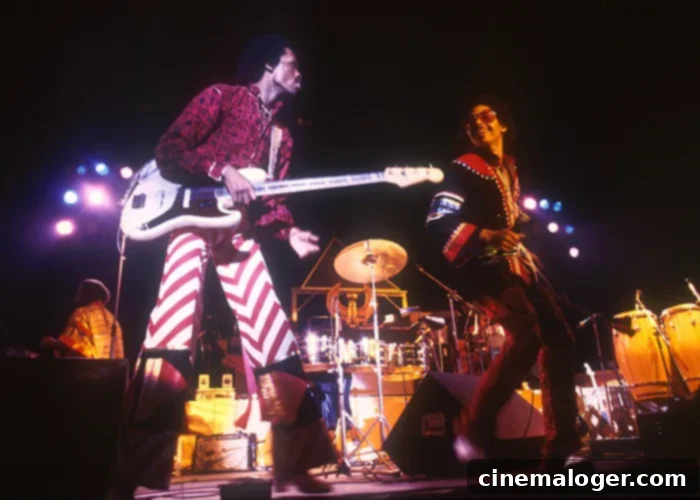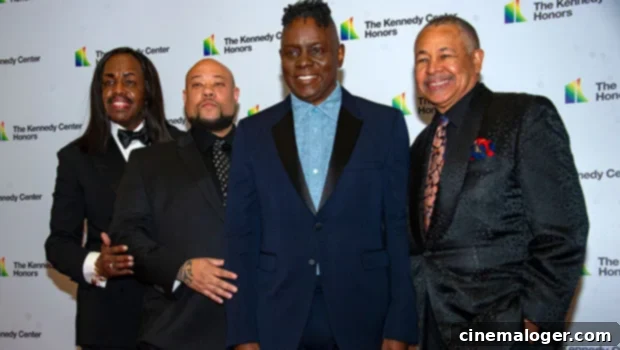Earth, Wind & Fire: Unveiling the Enduring Legacy of an Iconic Musical Phenomenon
Since their vibrant introduction in 1969, Earth, Wind & Fire has captivated the world with a sound that transcends genres and generations. This legendary R&B and disco band has consistently delivered stellar hits, weaving a rich tapestry of funk, soul, jazz, and pop into a truly unique musical experience. Their enduring appeal is evident in timeless tracks like “September” and “Let’s Groove,” which continue to resonate with audiences across the globe. From their electrifying live performances, such as their recent appearance on the season 24 finale ofThe Voice, to their extensive discography, Earth, Wind & Fire represents a pinnacle of musical artistry and innovation. This article delves deep into the journey of this iconic group, exploring its rich history, the talented musicians who shaped its sound, and the profound legacy they have built over five decades.
The Genesis of a Musical Powerhouse: From The Salty Peppers to Earth, Wind & Fire
The story of Earth, Wind & Fire began in Chicago in 1969, fueled by the visionary spirit of musician Maurice White. Initially, the band was known as The Salty Peppers, formed by Maurice alongside Wade Flemons and Don Whitehead. Maurice, a former session drummer for Chess Records and a member of Ramsey Lewis Trio, harbored an ambition to create a band that would blend diverse musical styles with a profound spiritual message. His unique astrological sign, Sagittarius, which has a primary elemental ruler of Fire, and secondary rulers of Earth and Air (often interpreted as Wind), inspired the iconic name change in 1970. This new name symbolized not only the elements but also the universal and spiritual themes that would become central to the band’s identity.
Shortly after the name change, Maurice’s younger brother, Verdine White, a dynamic bassist with an undeniable stage presence, joined the group, solidifying a crucial part of the band’s future core. The nascent group, now known as Earth, Wind & Fire, signed with Warner Bros. Records and released their self-titled debut album in 1971. This initial offering, while not a commercial blockbuster, laid the groundwork for their distinctive sound, showcasing their fusion of jazz, funk, and soul. It was a clear declaration of their artistic intent and set the stage for the groundbreaking music that would follow.
Shaping the Sound: The Evolution of Earth, Wind & Fire’s Unique Musical Style
Earth, Wind & Fire quickly distinguished itself with a sound that was unlike anything else in popular music. They masterfully blended R&B, soul, funk, disco, jazz, pop, rock, and even African and Latin influences, creating a vibrant, complex, and irresistibly danceable groove. This eclectic fusion was characterized by several key elements:
- Maurice White’s Vision: As the bandleader, Maurice envisioned a sound that was not only musically innovative but also spiritually uplifting. He incorporated philosophical themes, positive messages, and elements of ancient cultures into their lyrics and album artwork.
- The Vocal Harmonies: The interplay between Maurice White’s smooth baritone and Philip Bailey‘s soaring falsetto became a signature element. This vocal contrast, often layered with intricate harmonies from other members, gave their songs a rich, ethereal quality.
- The Phenix Horns: A powerhouse horn section, often referred to as “The Phenix Horns,” was instrumental in defining EWF’s sound. Their precise, dynamic, and often elaborate arrangements provided a jazz-fusion edge that elevated many of their tracks from simple pop songs to sophisticated musical compositions.
- Verdine White’s Basslines: Verdine’s energetic and melodic basslines were the pulsating heart of the band’s rhythm section, providing a foundation that was both groovy and intricate.
- Sophisticated Arrangements: The band’s musical arrangements were known for their complexity, incorporating diverse instrumentation, intricate percussion, and often unexpected shifts in rhythm and melody.
This innovative approach led to a string of highly successful albums and singles throughout the 1970s and early 1980s, firmly establishing Earth, Wind & Fire as one of the most important and influential bands of their era.
A Constellation of Hits: Iconic Albums and Chart-Topping Singles
Earth, Wind & Fire’s discography is a treasure trove of musical gems, with numerous songs achieving global recognition and becoming staples of popular culture. Their peak commercial success arrived in the mid to late 1970s, yielding a remarkable series of platinum albums and hit singles.
- “Shining Star” (1975): This electrifying funk anthem from the album That’s the Way of the World became their first No. 1 hit on the Billboard Hot 100, earning them a Grammy Award for Best R&B Vocal Performance by a Duo, Group or Chorus.
- “That’s the Way of the World” (1975): The title track from their sixth studio album, this soulful ballad showcased their versatility and Maurice White’s distinctive vocals. The album itself topped the Billboard 200 chart.
- “Reasons” (1975): A classic slow jam, this track from That’s the Way of the World remains a fan favorite, largely due to Philip Bailey’s breathtaking falsetto.
- “Fantasy” (1978): From the album All ‘n All, “Fantasy” is a testament to the band’s spiritual and cosmic themes, featuring lush arrangements and captivating vocals.
- “Boogie Wonderland” (1979): A collaboration with The Emotions, this disco-era classic became an international smash hit, embodying the vibrant energy of the disco movement while retaining EWF’s signature sound.
- “September” (1978): Perhaps their most universally beloved song, “September” is an irresistible earworm that transcends time. Its joyful melody, catchy lyrics, and incredible musicianship have made it an enduring anthem for celebrations worldwide. The song’s iconic “Ba-dee-ya!” refrain is instantly recognizable, and its perpetual presence in films, commercials, and parties solidifies its status as a timeless classic.
- “Let’s Groove” (1981): A vibrant and energetic track from the album Raise!, “Let’s Groove” marked the band’s continued relevance into the early 1980s, combining their signature funk with contemporary synth sounds. It became another global hit and a dance floor filler.
Other significant albums include Gratitude (1975), a live album that captured their dynamic stage presence, and I Am (1979), which featured “Boogie Wonderland” and the soulful ballad “After the Love Has Gone.” These works, alongside many others, cemented Earth, Wind & Fire’s status as prolific hitmakers and innovative musical architects.
The Ever-Evolving Lineup: Who Is in Earth, Wind & Fire Now?
Like many long-standing bands, Earth, Wind & Fire has seen various musicians contribute to its storied history. While the core vision remained with Maurice White, the band’s lineup evolved over the decades. Today, the legendary pop-disco group continues to perform with a dynamic ensemble that carries forward the band’s rich legacy.
Current prominent members include:
Verdine White: The iconic bassist, whose energetic stage presence and incredible basslines have been a constant since the early days.
Philip Bailey Sr.: The legendary lead vocalist, renowned for his extraordinary falsetto range and a member since 1972. Philip took a hiatus in 1984 but triumphantly returned in 1987 and has been a driving force of Earth, Wind & Fire ever since.
Ralph Johnson: A multi-talented percussionist and vocalist, another long-serving member who joined in 1972.
The current touring lineup also features:
Philip Bailey Jr.: Following in his father’s footsteps, Philip Jr. joined the band in 2008, contributing backup vocals and other instruments, ensuring the continuation of the family legacy.
B. David Whitworth: Percussion and vocals.
Myron McKinley: Keyboards and musical direction.
John Paris: Drums.
Morris O’Connor: Guitar and vocals.
Serg Dimitrijevic: Guitar and vocals.
This talented ensemble ensures that the magic of Earth, Wind & Fire’s live performances continues to thrill audiences worldwide, delivering faithful renditions of their classic hits with fresh energy.

Remembering the Departed: Past Band Members of Earth, Wind & Fire
Over more than five decades, a multitude of exceptionally talented musicians have passed through the ranks of Earth, Wind & Fire, each leaving an indelible mark on the band’s sound and history. While space prohibits detailing every single contributor, here is a list of some of the notable artists who have been part of the Earth, Wind & Fire family:
Jessica Cleaves, Ronnie Laws, Roland Bautista, Larry Dunn, Andrew Woolfolk, Al McKay, Fred White, Sheldon Reynolds, Phenix Horns (individual members often changed), Doug Carn, Sonny Emory, Dick Smith, Vance Taylor, Fred Ravel, David Lautrec, Greg Moore, Morris Pleasure, Robert Brookins, Daniel de los Reyes, Kimberly Brewer, Kim Johnson, Krystal Bailey, Johnny Graham, and Don Myrick.
A profound loss for the band and the music world was the passing of founder Maurice White in February 2016. Maurice had been battling Parkinson’s disease for many years, which forced him to stop touring with the band in 1994, though he remained actively involved in production and songwriting. His legacy as a musical innovator, spiritual guide, and bandleader is immeasurable, and his vision continues to steer the band’s direction.
Accolades and Lasting Cultural Impact
Earth, Wind & Fire’s monumental contributions to music have been recognized with numerous prestigious awards and honors throughout their career. They have earned an impressive array of accolades, including six Grammy Awards out of seventeen nominations, highlighting their consistent excellence in various categories. Their collection also includes four American Music Awards and a BET Award, underscoring their broad appeal and impact across different musical landscapes.
In 2000, Earth, Wind & Fire was inducted into the Rock and Roll Hall of Fame, a fitting tribute to their pioneering sound and influence. They also received a star on the Hollywood Walk of Fame, further cementing their place in entertainment history. Beyond awards, their songs have become cultural touchstones, frequently sampled by hip-hop artists, featured in countless films and television shows, and streamed by millions worldwide.
The band’s story, particularly Maurice White’s journey and the group’s early beginnings, was partly explored in the 2003 film Baadaasssss!, though a comprehensive biopic of the entire band’s history has yet to be produced. This speaks to the depth and richness of their narrative, which continues to inspire and entertain.
The Enduring Legacy of Earth, Wind & Fire
More than fifty years after their inception, Earth, Wind & Fire remains a vibrant force in the music industry. Their unique blend of funk, soul, R&B, and spiritual themes created a sound that was ahead of its time and continues to be deeply influential. They taught the world to “groove” with a message of universal love, peace, and harmony. Their elaborate stage shows, innovative arrangements, and timeless melodies have secured their place as one of the most beloved and respected bands of all time. Earth, Wind & Fire’s music is a testament to the power of artistic vision, collaboration, and the enduring human desire for joy and connection, ensuring their legacy will continue to shine brightly for generations to come.
